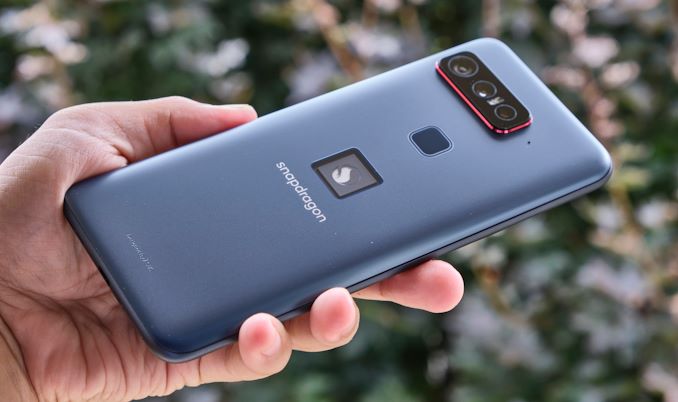
Today we’re reviewing a rather unusual device, the new ASUS “Smartphone for Snapdragon Insiders”. The device had been first announced a month ago by Qualcomm and ASUS, and represents a sort of weird kind of collaboration between the two companies. The phone follows a push by Qualcomm in social media and marketing to try to promote their Snapdragon brand, and a program called the Snapdragon Insiders initiative.
The “Smartphone for Snapdragon Insiders” – a rather unintuitive name which we’ll shorthand as SSI from here on, is weird in that while it’s primarily pushed by Qualcomm marketing, it’s actually an ASUS designed and manufactured product. The initial announcement of the device was a bit confusing in that one would have thought it’s a Qualcomm developed phone, but the relationship is rather a bit more blurred and complex. For the time being, you can think of the phone as simply being another ASUS device, with Qualcomm Snapdragon branding.
For today’s review (which we’re calling a preview for the time being, more on this later), there’s one extremely notable parallel which we can’t help making, and that is the comparison to ASUS’ own ROG Phone 5 phone which was announced and released earlier in the year. As both devices are designed and manufactured by the same party, there’s going to be some extreme similarities between the phones – so comparing them and pitting them against each other is an inevitability in my eyes.
Disclosure: Qualcomm has sent us a free review unit of the "Smartphone for Snapdragon Insiders" for review. The review is an independent evaluation of the product.
| ASUS Big Phones | |||||
| ROG Phone 5 |
"Smartphone for Snapdragon Insiders" |
||||
| SoC | Qualcomm Snapdragon 888 1x Cortex-X1 @ 2.84GHz 3x Cortex-A78 @ 2.42GHz 4x Cortex-A55 @ 1.80GHz Adreno 660 @ 840MHz |
||||
| DRAM | 8/16 GB LPDDR5 | 16 GB LPDDR5 | |||
| Storage | 128/256GB UFS 3.1 | 512GB UFS 3.1 | |||
| Display | 6.78" AMOLED 2448 x 1080 (20:9) 144Hz 240Hz Touch |
||||
| Size | Height | 173.00 mm | 173.15 mm | ||
| Width | 77.00 mm | 77.25 mm | |||
| Depth | 9.90 mm | 9.55 mm | |||
| Weight | 239 grams | 210 grams | |||
| Battery Capacity | 5770 typ (2x 2885) 22.33Wh "6000mAh" design 65W charging (PD3.0/QC5.0) |
"4000mAh" 65W charging (PD3.0/QC5.0) |
|||
| Wireless Charging | - | ||||
| Rear Cameras | |||||
| Main | 64MP IMX686 0.8µm pixels (1.6µm 4:1 16MP) f/1.8 26.6mm eq. |
||||
| Telephoto | - | 8MP 3x optical zoom f/2.4 w/OIS 80mm eq. |
|||
| Wide | 12MP IMX363 1.4µm pixels Dual PDAF f/2.2 14.3mm eq. |
||||
| Extra | 5MP Macro | - | |||
| Front Camera | 24MP f/2.45 |
||||
| I/O | USB-C 3.5mm headphone |
USB-C | |||
| Wireless (local) | 802.11ax WiFi-6E Bluetooth 5.2 LE + NFC |
||||
| Other Features | In-display fingerprint sensor | Rear fingerprint sensor Global 5G (sub-6 + mmWave) |
|||
| Dual-SIM | Dual nanoSIM | ||||
| Launch Price | (16/256GB) $999 |
(16/512GB) $1499 |
|||
Starting off with the hardware, the SSI is powered by Qualcomm’s Snapdragon 888 SoC. Qualcomm had noted that the phone doesn’t contain the newer Snapdragon 888+ because the phone was already in design and production before the S888+ came to market, so they opted to use that platform for the device and avoid delaying it further.
What’s a bit special about the Smartphone for Snapdragon insiders is a few changes in the internal hardware. First off, the phone only comes in a single configuration, with a whopping 16GB of LPDDR5 and 512GB of UFS 3.1 storage. Generally, this is already one of the aspects which puts the phone at a higher price tier compares to other devices, so it’s important to keep this in mind.
The other important aspect of the SSI is its cellular network compatibility and radio front-end and antenna design: To keep it simple, this phone supports every single 5G frequency band in the world – including full mmWave support, something that is unique to the phone and can’t be found in any other device in the market. Generally, the inclusion of radio front-ends to support every single frequency band for every cellular market in the world is a bit unusual as most vendors attempt to optimise the internal hardware of the devices to simply support the frequency bands available in the target market, and simply develop a few different models that target certain markets (North America, EMEA, “Global” models, China, Japan). In the case of the SSI, it’s certainly quite a flex in terms of hardware capabilities – however, unless you’re an extremely international traveller and have according cell plans, it will be something for the very vast majority of users won’t be of practical advantage.
The phone features the same display and general form-factor as the ROG Phone 5. The 6.78” AMOLED feature a 2448 x 1080 resolution and goes up to 144Hz refresh rate, along with a 240Hz touch input sampling rate.
As noted in our announcement article, it really does seem here that the panel and the whole front glass assembly for the SSI is identical to that of the ROG Phone 5.
When face-on, the only real distinguishing factor between the two devices is the fact that the SSI doesn’t have the bottom front speaker slit, and instead uses a bottom-firing speaker. What’s interesting here is that there’s still a glass cut-out where the speaker slit is supposed to be, it’s just that is serves no purpose.
The form-factor of the phones is mostly identical; however, the SSI is 0.4mm thinner and 29g lighter than the ROG Phone 5. The reason for the smaller weight is a much smaller battery capacity – instead of the giant 6000mAh of the ROG 5, the SSI only features “a mere” 4000mAh. This is actually a 33% reduction – or better said, the ROG Phone 5 has a 50% larger battery. This will be quite worrying for the battery performance of the phone as we’ll see later.
The top of the SSI is practically identical to the ROG Phone 5 with zero differences alongside the glass face.
One difference in design between the phones is that the ROG Phone 5 employs a chamfer below the plastic “gasket” along the display glass, whereas the SSI avoids this and simply immediately starts the rounded metal frame of the device.
The backside of the phones is characterised by ASUS’s LED elements – this time around it swaps the ROG logo for a 3D Snapdragon logo – it’s actually a three-dimensional element that’s around 2mm deep below the back glass panel, and which lights up.
The internal hardware designs of these phones have the motherboard PCB actually placed in the very middle of the phone frame in a horizontal fashion – ASUS had designed this with the Aero Cooler accessory in mind, along with the secondary USB-C port to the side of the ROG Phones. These accessories of course don’t exist for the SSI – placing the Snapdragon logo here is a bit odd in terms of the thermals of the phone, which we’ll dwell deeper later.
Also notable on the backside of the SSI is the fact that there’s a fingerprint sensor. This is Qualcomm’s latest ultrasonic fingerprint sensor, however the fact that it’s on the backside of the phone seems a bit odd, and generally counterintuitive to the point of the sensor technology.
Qualcomm explains here that the phone uses a solid glass OLED substrate rather than the flexible OLED type, and this former generally cheaper panel type is not compatible with Qualcomm’s ultrasonic fingerprint sensors. This is a bit of a tough situation for the SSI – on one hand it would have been weird if a Snapdragon branded phone had to use a regular optical under-display fingerprint sensor from a regular provider, but this implementation of the ultra-sonic Qualcomm sensor is also generally a bit pointless and definitely not the best showcase of the technology.
At the bottom of the phone, there quite notable differences between the phones. We mentioned the bottom-firing speaker – generally the implementation here is not as good as what we have on the ROG Phone 5, and the audio isn’t as even. I’m not really sure why there was a need to change the layout.
Furthermore, what’s missing on the SSI is the 3.5mm headphone jack. ASUS is one of the rare few hardware vendors to still provide the 3.5mm headphone jack in their phones nowadays and actually pride themselves in the feature – which is good. The Snapdragon phone losing it is rather odd, but generally in line with what we’ve seen from OEMs over the years, instead opting to promote wireless alternatives.
In terms of camera setup, the SSI uses the same main sensor and ultra-wide as the ROG 5- however the main sensor gains OIS, and instead of a 5MP macro module we see the inclusion of a 8MP 3x optical zoom – the same hardware that’s included in the Pro models of the Zenfone 7 and the Zenfone 8 Flip. What’s interesting here is that it seems while the UI interface of the camera is identical to other ASUS phones, Qualcomm had taken up the task to calibrate and optimise the camera processing for the device – which is one of the critical differences to other ASUS phones.
The Smartphone for Snapdragon Insiders is rather special in terms of the wireless audio options – the phone comes along with a pair of Snapdragon branded Master & Dynamic MW08 (MW08S in this case) ANC earbuds. The non-branded variant of these TWS actually come at a MSRP of $299, so it’s actually a very substantial value proposition of the $1499 package of the SSI.
System performance of the SSI is rather straightforward: With the well known Snapdragon 888 which we’ve review in tons of devices to date, along with ASUS’s software stack, and the device’s 120/144Hz panel, it should perform extremely well.
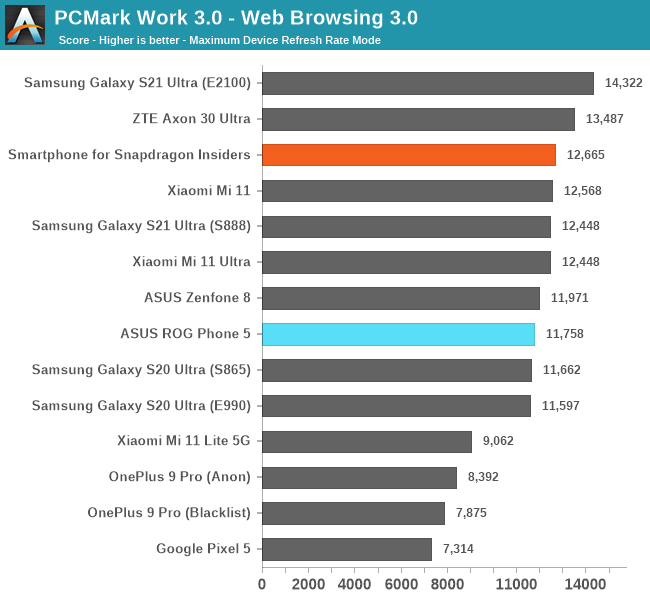
In the web-browsing test in PCMark Work 3.0, the SSI is a little bit faster than the ROG 5.
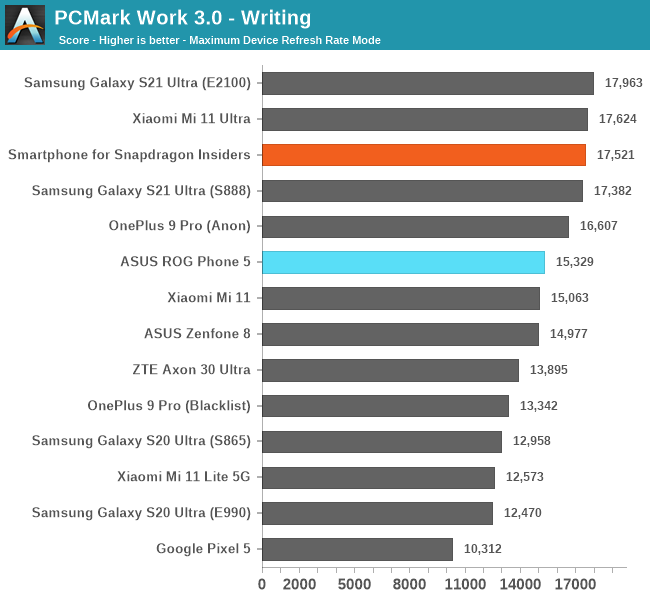
The writing subtest shows a more substantial advantage in favour of the SSI, indicating that there’s actually some more notable BSP and scheduler/DVFS differences between it and the ROG 5. It’s in line with the performance of the Mi 11 Ultra and the Galaxy S21.
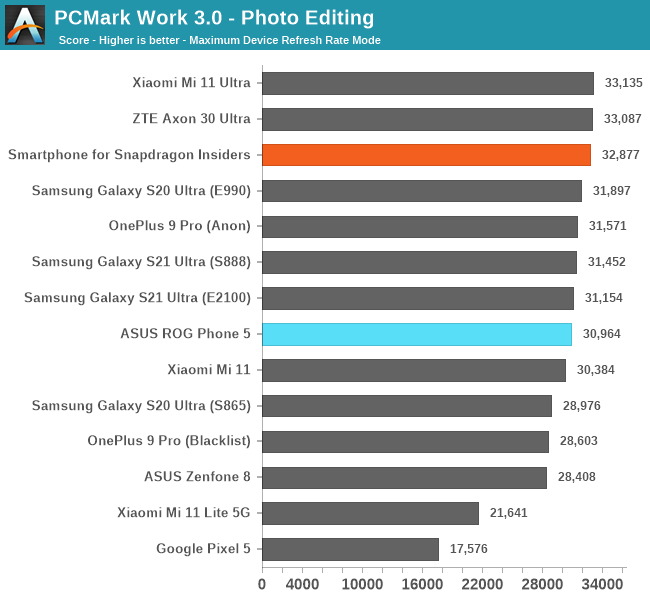
Photo editing falls in line with the Mi 11 Ultra and the Axon 30 Ultra.

Oddly enough, both the ROG 5 and the SSI top the charts in the data manipulation test, showcasing similar OS optimisations.
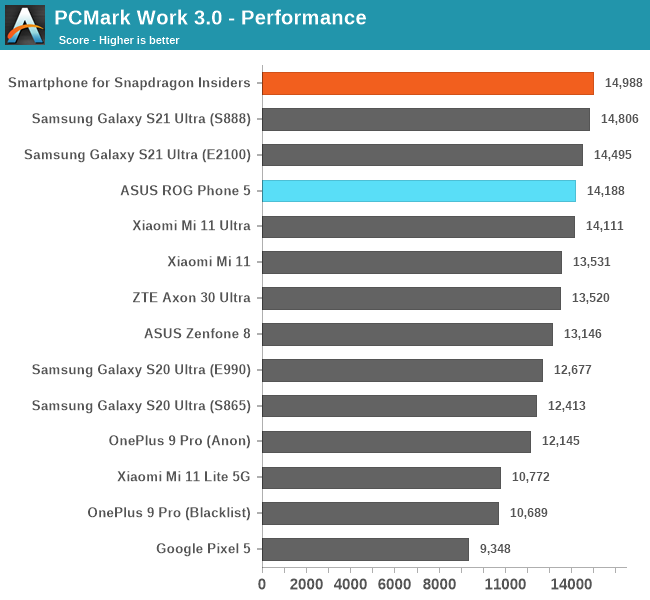
In the overall performance scores, the SSI ends up as the top performing Android device, thanks to its more aggressive tuning.
Web Browser Performance

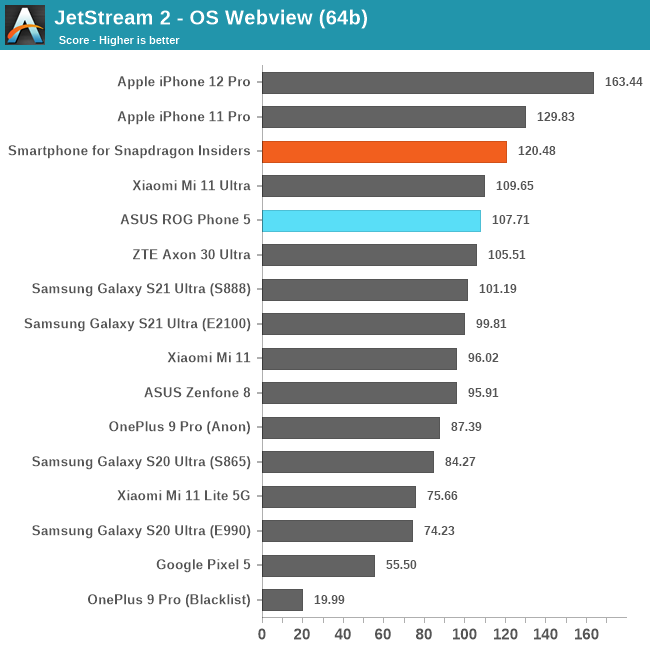
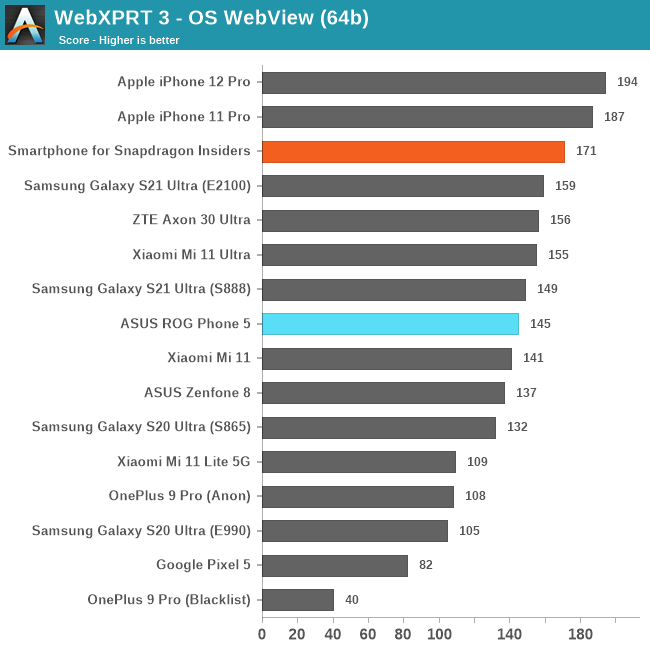
The web browser results are a bit of a mix between being in line with the ROG Phone 5 and being actually quite ahead of all other Snapdragon 888 phones on the market. Particularly the extremely high WebXPRT 3 scores showcases that the SSI is a lot more aggressive in terms of DVFS than any other Snapdragon powered device.
The overall system performance of the Smartphone for Snapdragon Insiders is excellent and outstanding The extremely fast responsiveness of the software as well as for the fast chip, along with the very high refresh rate as well as the low latency input means that it’s amongst one of the fastest and snappiest devices on the market.
GPU performance of the Smartphone for Snapdragon Insiders will be very interesting to see. We’ve covered very early on in the year the power characteristics of the Snapdragon 888, lamenting the SoC’s extremely high peak power states. Qualcomm at the time had explained the SoC had higher TDP headroom because there were devices on the market which would be able to support more thermal dissipation. Generally, I disagree with the later statement, as “slab” like smartphones generally a limited to a combined convection and radiation thermal envelope of around 4-5W in a 21-23°C environment. Anything beyond that would only be achievable via active cooling, such as ASUS’s Aero Cooler accessory.
The SSI has no option for active cooling, so it was surprising to me that the phone still had a “High performance” mode in its settings. Although the phone comes in the default “Dynamic” state, I was curious and tested the HP mode:
What resulted is a rather shocking thermal behaviour where the phone literally would not thermal throttle, reaching peak skin temperatures of over 59°C in the middle of the phone’s screen where the SoC and motherboard is located. This is actually the highest figure I’ve ever encountered on a phone ever – past Huawei phones would shut off at this stage, and Xiaomi phones also give off an overheating warning well below this. I stopped the stress test from going any further – this is above first-degree burns temperatures and treading into second degree burn category. Out of principle I just refuse to test devices in such incomprehensible thermal behaviours. The ASUS ROG Phone 5 also has such mode, however it’s only ever available to be enabled only when the external cooling fan is connected, thus never reaching these kinds of temperatures.
In the default “Dynamic” mode, the phone peaks at skin temperatures around 43°C, which is in line with industry standards. The benchmark scores presented are in this mode.
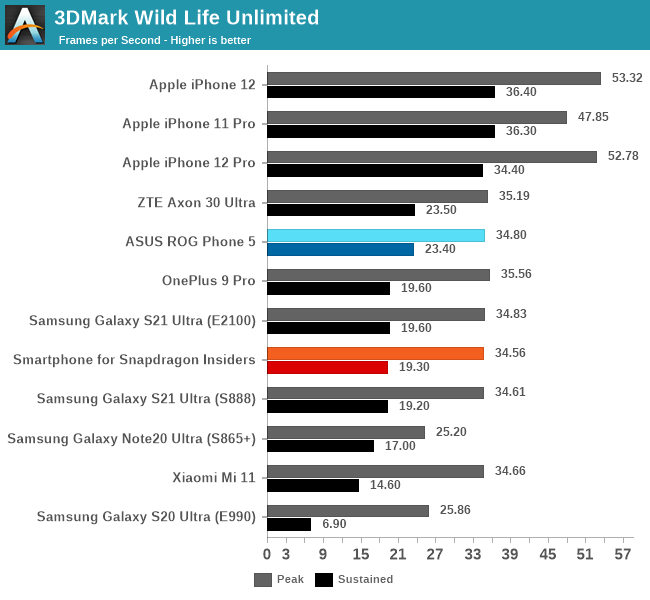
Unfortunately, in this mode, we’re seeing the SSI perform quite averagely. It’s in line with other phones which have similar 42-44°C peak skin temperature limits, however it notably underperforms the ROG Phone 5.





The reason for why the SSI underperforms the ROG Phone 5 is what I had suspected in the introduction, in that the both phones have the SoC and motherboard PCB located at the centre of the phone. The SSI has this Snapdragon logo window located here, which I suspect is acting as a thermal insulator, and reducing the surface area of thermal dissipation from the PCB to the glass back panel. This is just my personal theory just looking at how the phones are built and how the heat is dissipating compared to the ROG 5.
The SSI’s performance here is just mediocre to bad, however it was also to be expected given the SoC’s thermal characteristics. Physics are physics, and there is simply no way for any device out there to sustain more than 5W at reasonable skin temperatures at common indoor ambient temperatures – no matter the internal heat dissipation mechanisms, be it heat pipes, vapour chambers or newer graphite sheets. The SSI is still a glass slab phone like any other, and therefor it will perform like any other due to the fundamental limitations.
The display of the SSI is generally no different from the ROG Phone 5 – which in turn wasn’t much of a change form the ROG Phone III. At 2448 x 1080 on a 6.78” it’s not quite the sharpest and naturally doesn’t compete with newer QHD 120Hz devices on the market, however it’s still enough for most people.
The phone really lacks any kind of modern panel technologies, such as VRR, and it’s also notable that it has worse viewing angles, which I suspect is due to the glass substrate OLED panel.
Colour calibrations is identical to the ASUS ROG Phone 5 – and comes with the same software options for customisation. We’re measuring the “Standard” preset which targets sRGB colour space for general content.
We move on to the display calibration and fundamental display measurements of the Smartphone for Snapdragon Insiders screen. As always, we thank X-Rite and SpecraCal, as our measurements are performed with an X-Rite i1Pro 2 spectrophotometer, with the exception of black levels which are measured with an i1Display Pro colorimeter. Data is collected and examined using Portrait Display's CalMAN software.

In terms of brightness, manual maximum brightness goes to 450 nits, which when in automatic brightness mode and under brightly lit environmental conditions, the device goes up to 734 nits full screen white. It’s a generally very competitive screen, though not quite up to par with cutting-edge devices.
In terms of greyscale colour accuracy, the phone has one of the most perfect D65 white points I’ve ever seen in a device at 6524K, so a big applause for ASUS there. Unfortunately, the gamma isn’t great, and is consistently higher than the 2.2 target one uses for consumer content.
What this means is that tones, particularly at lower intensities, will look darker than they’re supposed to.
The phone does adequately in the saturations accuracy, however we see that reds are off-hue, and in general mid-point levels on all colours are undersaturated.
The GMB patches of common tones and skin tones actually fares well for the SSI when it comes to colours themselves, with a dEITP of 2.17 when luminance compensated, but because of the higher gamma target, we’re seeing the aggregate score be quite bad, and we see the differences in the colour comparator strip.
In general, the screen of the Smartphone for Snapdragon Insiders is essentially identical to that of the ROG Phone 5. The problem is that that panel wasn’t very competitive in the 2021 device landscape. Rather low resolution for the device size, non-competitive viewing angles due to a cheaper glass substrate OLED panel, and the lack of any power saving features make this a strictly 2019 era flagship screen. That’s just not really a fitting combination for a $1500 phone.
Battery life for the Smartphone for Snapdragon Insiders is interesting for one fact alone: Qualcomm and ASUS’ decision to equip the device with a much smaller 4000mAh battery. While that figure alone isn’t particularly small for a regular device, the industry has seen steadily growing battery capacities over the years. 4000mAh is actually the same size battery that ASUS is employing in the small form-factor Zenfone 8, and the ROG Phone 5 has a massive 6000mAh unit, so naturally we’re expecting quite a massive difference in the battery performance.
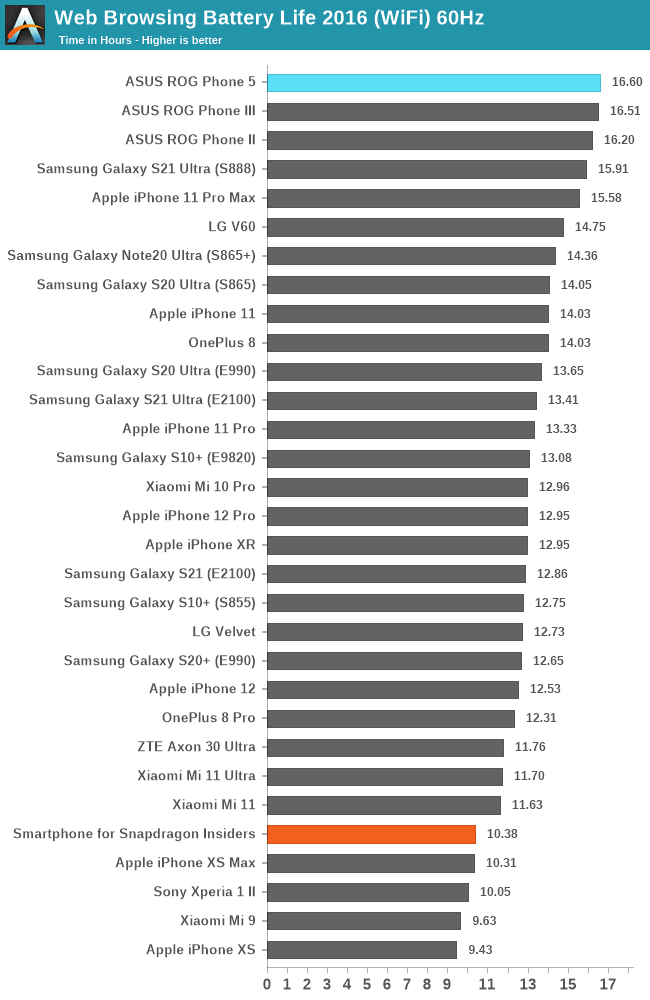
As expected, the 60Hz web browsing scores of the SSI are just horrible and massively disappointing. At 10.38 hours runtime, this is only 62% of the battery life presented by the ROG Phone 5 under the same test conditions. The SSI’s battery is 66% of the sibling device’s size, and the further difference could be explained by the more aggressive performance characteristics of the SSI.
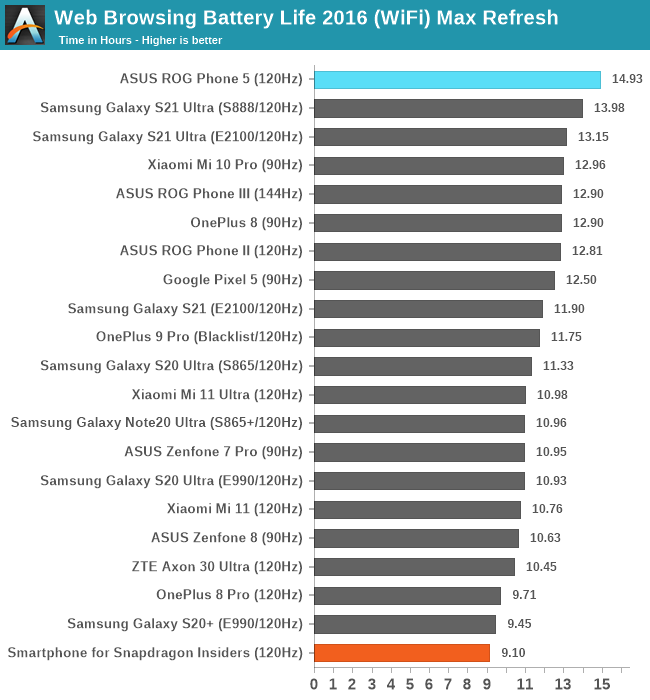
At 120Hz, which I opted for instead of the 144Hz maximum of the phone just for apples-to-apples purposes, the device ended up as the shortest lasting high refresh phone we’ve recently tested. At only 60.9% of the ROG Phone 5’s battery life, we’re seeing two polar opposites in terms of the runtime in our chart.
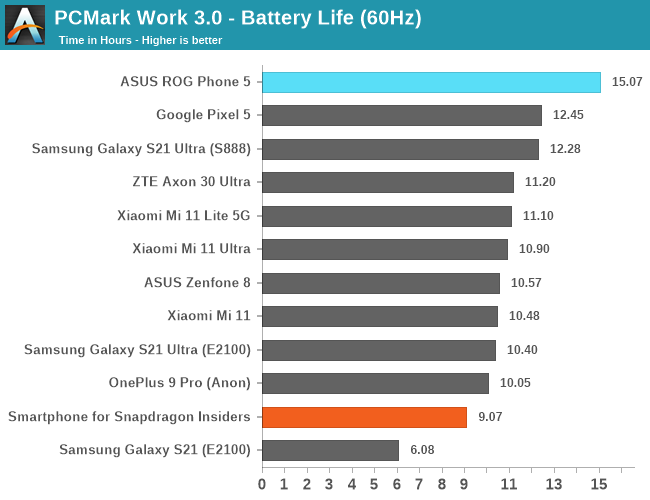
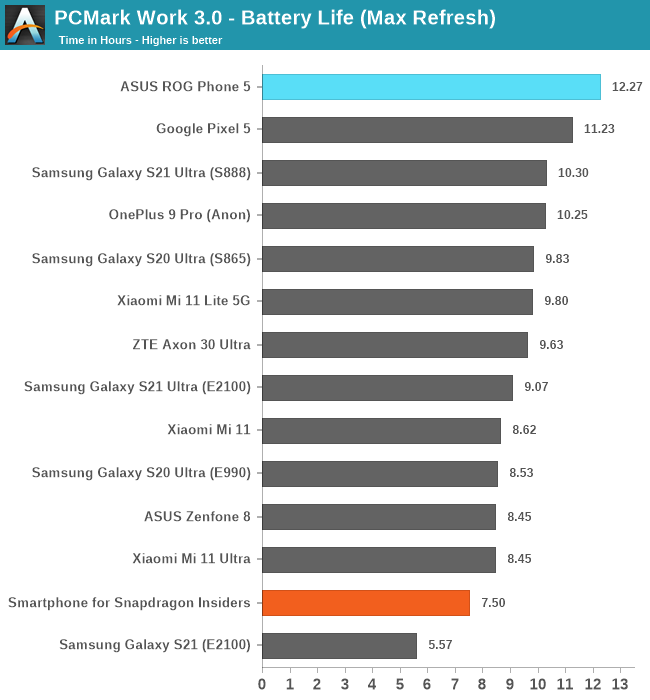
In PCMark, it’s again the same story. Besides the Exynos 2100 regular small S21, the Smartphone for Snapdragon Insiders ends up as the worst performing device in recent testing.
Overall, the SSI is just a perplexing phone. For the little weight difference and 0.4mm thickness differences, we’re getting a phone that’s really only less than two-thirds of the ROG Phone 5 when it comes to the battery life. This puts it amongst one of the worst performing Snapdragon 888 devices on the market when it comes to battery life, which is abysmal.
When we first covered the Smartphone for Snapdragon Insiders announcement a few weeks ago, we were under the impression that the phone was full ASUS product – as in Qualcomm had no involvement of the development of the phone. After we received a review unit from Qualcomm, the company had reached out to warn us that there was an upcoming firmware update towards end of August, which had “substantial” changes to the way the camera performed.
This was rather confusing, as it was worded that Qualcomm had done the optimisations – which is actually indeed what happened, and goes against our initial impression of the collaboration between the companies. In reaching out for clarification, a Qualcomm spokesperson explained the following differences to ASUS’s cameras, as well as what we are supposed to see in the upcoming major upgrade:
Regarding the camera update, the difference between this phone and a typical ASUS handset for camera are:
- This handset uses Qualcomm’s latest camera SW build including baseline Qualcomm features for MFNR, MCTF, EIS, HDR, etc.
- This handset has different component choices (sensors and lenses) vs. a typical ASUS handset
- This handset has SW features integrated from specific ISV partners, such as ArcSoft and Almalense
- This handset was tuned for best IQ by Qualcomm’s camera team
- This handset has ToF Laser for best lowlight autofocus accuracy
Here are the differences between the build you have now and the MR1.6 OTA updates coming later this month, which the DXOMARK score is based on:
- OTA will have upgraded camera tuning which will boost camera performance to a score of 133 (highest in the US)
- OTA will provide best autofocus experience, better texture/noise performance, and improved night shot quality
- OTA will enable Video Super Resolution
- OTA will add full resolution mode to improve snapshot performance
- OTA will add Cascaded Noise Reduction in video mode for cleaner video capture
- OTA fully optimizes:
- UW/Tele HDR– tone/artifact
- Low light and night modes– noise/brightness and stability
- Multi-frame noise reduction - snapshot noise reduction
- HDR snapshot – tone and stability
- Ultra wide camera – HDR will be better in viewfinder for this camera
Qualcomm goes further to explain that they’ve worked with DXOMark to evaluate the new camera software, and claim to have received a score of 133, the “highest in the US” (probably referencing against the S21 Ultra and OP9Pro's 123-124).
Unfortunately, we did not have access to this new firmware update, and thus weren’t able to test the performance of the camera. For what it’s worth, the camera performance out-of-box seemed generally in line with that of other ASUS phones as well as the ROG Phone 5, aside from obvious differences such as OIS.
Due to the exceptional claims made by Qualcomm for this upcoming firmware and camera update, I deemed it pointless to try to review the current camera performance of the SSI if it’s supposed to be vastly revamped and changed within a few weeks.
What is however interesting in talking to Qualcomm, is that the improvements for this touted firmware update will be exclusive to the Smartphone for Snapdragon Insiders – meaning it will not see the improvements translate to other ASUS phones such as the ROG Phone 5. This is actually a very important, and probably the only positive differentiation for the SSI over other ASUS alternatives. It’s also quite of a messy situation for ASUS if we do end up with the phone vastly outperforming the Zenfones/ROG Phones in the camera department.
We’ll be revisiting the topic in a few weeks once we have access to the new update. For this reason, this article is a “preview”, rather than a full review.
The Smartphone for Snapdragon Insiders comes with a pair of ANC TWS earbuds in the package. Due to their commercial value of $299 and the high price tag of $1499 for the whole package, the review wouldn’t really be complete without a more in-depth investigation into the audio department.
As a preface, Qualcomm has warned us that the samples we’ve received do not contain the newest “Snapdragon Sound” advantages such as higher bit-rate audio or higher quality voice. However as these are generally codec-related aspects of the earbuds, and we’re note really expecting changes to the fundamental sound signature and ANC performance of the units, we should still be able to review them as-is.
Originally manufactured by Master & Dynamic, the MW08S come in Snapdragon branded variants in the SSI package. The earbuds are characterised by their distinctive design and “D” shape. Though the branding is extremely visible and notable, it’s not so much different than the original MW08’s (besides the black variants).
The size of the earbuds is quite reasonable and they fit well in my ear – however the only real quirk with them I found is that the earbuds did not insert as deep as I’m accustomed, and I felt they were more loose than other designs. Although they kept into my ears, because of this always had a bit of paranoia of them falling out.
The pairs come in what I consider a quite large and heavy battery case. Although the buds themselves are still reasonable at 9g each (Airpods Pro: 5.4g, WF-1000XM4: 7.3g), the metal case is just massive at 81g (Airpods Pro: 45.6g, WF-1000XM4: 41g). The actual case with the earbuds inside weighs a whopping 98.5g, which is definitely noticeable in your pocket.
The earbuds can be controlled by M&D’s “Connect” app. It’s a pretty straightforward interface, and allows one to tune various ANC settings as well as the power off timer for the units. The units have settings between ANC turned off, “Max ANC”, “All Day ANC”, “Ambient Voice” and “Ambient Awareness”. The app lacked any further customisations options or equaliser settings.
Conveying subjective ANC performance (or any kind of subjective evaluation for that matter) is suboptimal, so for this piece I’m attempting to give out some objective measurements and actual recording off the actual earbuds, as measured by my ear measurement rig and microphone setup. This is not a professional setup, but gets us nearly there and should showcase the quality of the ANC.
Starting off with a baseline, I was playing back a frequency sweep out from my calibrated speakers. The output here is supposed to be quite flat and neutral, however we’re using a IEM compensation curve on the input, so it won’t be quite right, but that’s generally not what we’re looking for – we’re just interested in the delta difference in SPL.
The black curve is without earbuds, and the blue curve is with the passive isolation of just the earphones. As expected, the passive isolation is more dominant towards the higher frequencies, at 10-15dB, with very little isolation in the lower frequencies.
Turning on ANC, we’re looking at the graph of passive isolation versus the two ANC modes on the earbuds – “Max ANC” and “ANC All Day”.
Immediately, we’re seeing a massive difference in attenuation in the lower frequencies of almost 20dB, most effective between 100 and 300Hz. Higher frequencies above 1.5KHz are virtually unaffected by the ANC.
All Day ANC reduces the attenuation by quite a lot – essentially this mode is just a weaker ANC mode that while still limiting low frequency noise, isn’t nearly as aggressive in the very low frequencies.
The two pass-through modes are “ANC Ambient” and “ANC Voice”. In the former setting, essentially the earbuds record and replay all external audio, compensating the passive isolation. The voice mode still applies some ANC at frequencies below 300Hz, and is still quite strong at frequencies below 100Hz.
To demonstrate the ANC effectiveness in a subjective scenario, I’ve recorded the performance of the earbuds in two ambient noise scenarios, starting off with loud airplane ambient sound:
I recommend listening through headphones at higher volume to get the best effect. At the end of the video I remove the earbuds – calibrate your volume to be representative.
The ANC is extremely effective in massively attenuating the ambient low-frequency noise that’s typical of airplanes. The ANC Voice setting also allows one for conversations effectively.
I included also a restaurant scenario, though I wasn’t quite as happy with the recording. While the ANC drowns out most lower frequency noise, chatter is still evidently present.
Overall, the ANC performance of the MW08’s appeared to be quite adequate, and well performing for lower frequencies.
We’ve seen the industry move away from 3.5mm jacks to promote wireless audio – and the Smartphone for Snapdragon Insiders is a good example of that , especially in the juxtaposition against the ROG Phone 5 which does feature the jack.
Qualcomm here is risking quite a bit in terms of promoting their “Snapdragon Sound” brand – the MW08S earbuds case literally have a “How sound should sound” label inside of the battery case – a statement that’s almost certain to backfire if the earbuds don’t actually perform admirably well.
Starting off with frequency response curves, I pitted the MW08S against a pair of Jabra 75T’s which Qualcomm also had sent out in last year’s Hawaii event, as well as a pair of $27 BLON-BL03’s wired headphones which are regarded as performing extremely well for the price range. The measurements here were calibrated to 90db SPL pink noise, and all earbuds were using identical tips.
Unfortunately, the MW08s seem to be characterised by a large trough at 2.5KHz as well as larger peaks at 5.5KHz. Generally, I would ignore anything above 10KHz as my measurement setup here isn’t particularly accurate to proper professional equipment. The Jabra units provide a much flatter sound signature, though there’s quite a notable low bass boost.
A further problematic aspect of the M&D buds is a peak of very high distortion from 3.5 to 6KHz, peaking at over >6% THD+N, which is a quite horrible figure. On the positive side, low frequencies on the MW08’s are very clean.
The Jabra 75t’s in comparison have worse bass characteristics, however the majority of distortions are mostly kept under 1% THD, with only a smaller peak at 2.8KHz.
The high distortion characteristics of the MW08’s are I think responsible for a much narrower and more muddy sound-stage, that well inferior to the much cheaper Jabra earbuds.
Again, to be able to be able to properly convey the sound experience, I’m recording and comparing actual music (the excellently mastered Chris Jones – Long After You Are Gone) as recorded on the MW08’s compared to the aforementioned BL-03 wired headphones. As a reference, I’m also switching over audio to the original audio track source, and switching in-between the sources and recordings as highlighted in the video. Unfortunately, I wasn’t able to record the Jabra 75t units in stereo due to the units disconnecting from each other in the test rig, and recombining independently recorded channels resulted in an inaccurate representation.
There are two important aspects to note about the MW08’s – although the instrumentals are quite good, it’s noticeable that the vocals are very much underrepresented and feel a bit muffled, which would correspond to that 2.5KHz trough in the FR. Secondly, this recording in my view gives a good representation of the narrow sound stage of the MW08’s, which is very evident compared to both the original source as well as the BL-03’s. The MW08’s here also fared worse than the Jabra 75t’s which also had a much wider sound stage and imaging capabilities.
Finally, I wanted to take opportunity to talk about TWS DAC noise. Because wireless earbuds/headphones generally have to deal with battery power, their DACs are amplifiers are generally quite weak and more conservative in their designs, in order to achieve better battery life. One aspect that’s I’ve noted for years here is that most audio solutions still suffer from horrible noise floor characteristics, which is accentuated by extremely slow and non-responsive noise gating. Noise gating is when the DAC cuts off its output to the speakers.
Overall, the MW08’s – while for me had quite good and respectable ANC, just in my opinion fell apart when it comes to audio quality at this price range. The Jabras at half the price sound significantly better, and both get blown away by a set of $27 Chi-Fi 3.5mm wired earphones.
Unfortunately the industry’s move to drop 3.5mm jacks is very much motivated by the much higher profit margins of TWS – however at $299 and part of this $1499 Smartphone for Snapdragon Insiders package that presents itself as “How sound should sound”, this strategy just falls apart and is rather quite insulting, especially considering the cheaper ROG Phone 5 is able to provide true high fidelity sound via the 3.5mm jack.
As we’re coming to the end of this partial review – preview for the time being, I just can’t help but to ask myself “why?”. Qualcomm’s recent marketing push for Snapdragon Insiders made somewhat of a sense as a social media push, however the Smartphone for Snapdragon Insiders here is actually a hardware and product push. That’s an entirely different category of marketing, where when not executed or not done well, can actually backfire.
So, what is the SSI? In essence, it’s a crippled variant of the ROG Phone 5. Let’s break that down:
Things that don’t change is the display. The 6.78” AMOLED is essentially identical to that of the ROG Phone 5, from the panel up to the front glass of the phone, even up to the point of it still having a bottom front firing speaker indent even though this phone doesn’t actually have front firing speakers on both sides. The display was generally still adequate on the ROG 5, but that was a device at a $999 price point. For the $1499 SSI, it’s a rather lacklustre showing.
Performance of the phone is excellent, especially when it comes system performance, where the phone is likely the fastest Android device on the market. When it comes to GPU performance, having this as a Qualcomm Snapdragon branded phone with the Snapdragon 888 SoC at the core was a risky endeavour – either the phone would blow everything else out of the water, or it would fail to differentiate itself. The SSI ended up with the later scenario, unless you consider 59°C peak skin temperatures as a differentiation.
The single worst aspect of the SSI is its battery life. Although, yes, the phone is 29g lighter than the ROG Phone 5, it essentially comes at a +40% battery life hit, as the very aggressive performance settings and the downgrade from 6000mAh to 4000mAh causes it to fall from being one of the longest lasting devices on the market, to one of the worst battery life characteristics of any recent phone. This alone should be a complete disqualifier for the SSI versus the ROG Phone 5.
Qualcomm is making big promises on the camera department – however due to us not having access to that latest firmware update, this is an aspect of the phone that still remains an open question. Supposedly once this article goes live, DXOMark will publish their evaluation of the SSI with a very high score – if things indeed pan out for the device, then that would at least be a silver lining to an overall unbalanced package.
The $299 value ANC earphones included in the $1499 needed to be outstanding to be able to rationalise the whole cost of the overall package. Unfortunately, adequate ANC and mediocre audio quality was what we got. To add insult to injury, the SSI also drops the 3.5mm headphone jack which provides excellent audio quality on the cheaper ROG Phone 5.
Overall, the Smartphone for Snapdragon Insiders is a project that should not have been greenlit, and should not have gone to market. The very aspects of the ROG Phone 5 which make it an attractive option, such as outstanding battery life, the whole gaming accessory ecosystem, and the 3.5mm headphone jack, are things that are not present on the SSI. While the camera remains to be seen, the phone essentially does nothing better than the ROG Phone 5 – and that’s bad for Qualcomm’s first hardware attempt, as it diminishes the Snapdragon brand, and it’s bad for ASUS, for them ever actually agreeing to design such a device and diluting their smartphone line-up.
My initial reactions, impression, and resulting concerns, unfortunately came true, and it’s simply a device that makes no sense, and has absolutely no place in the market.
https://ift.tt/3iQiFOr
Bagikan Berita Ini
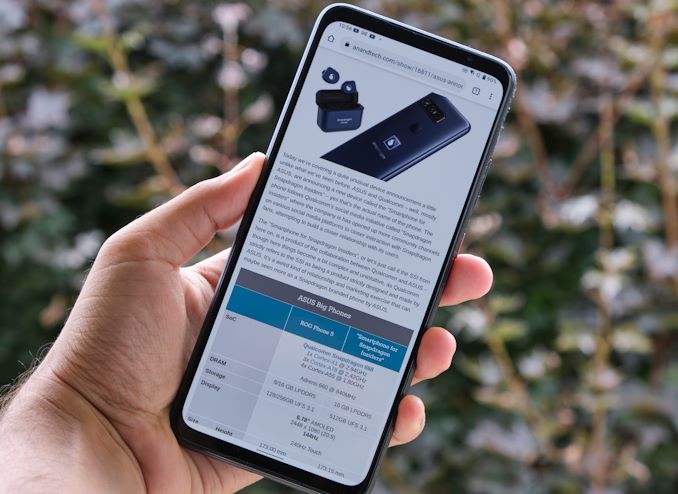
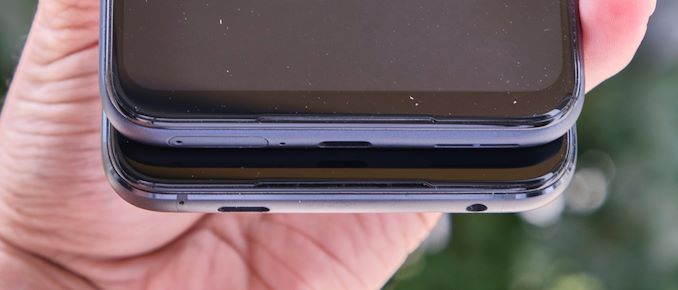
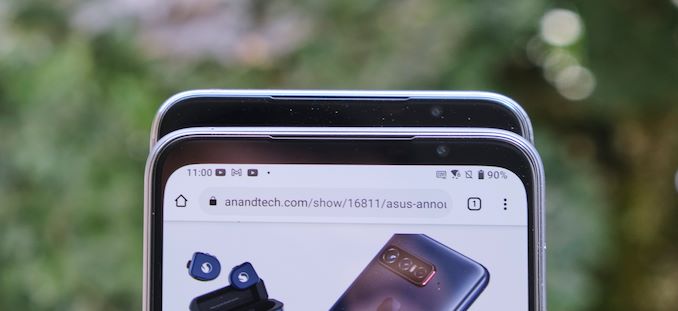
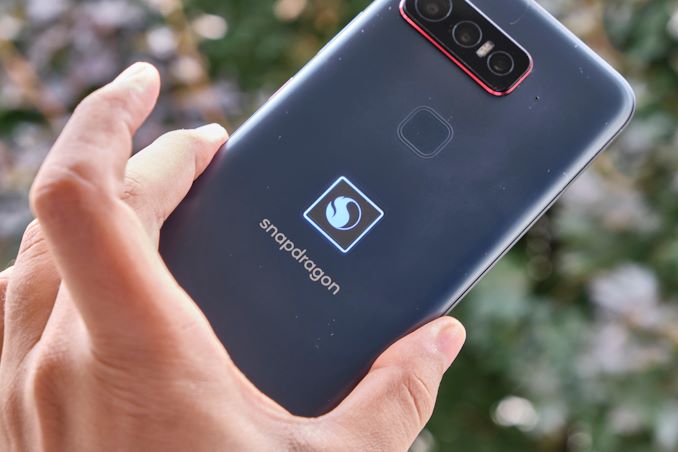



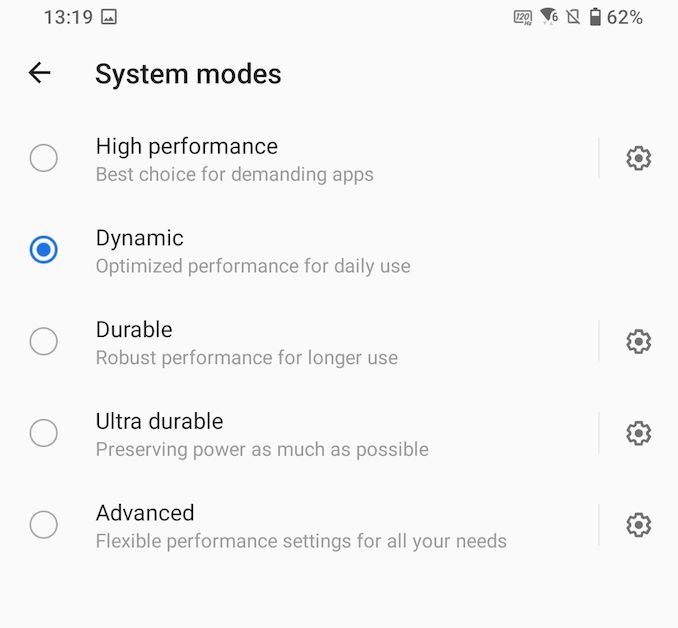
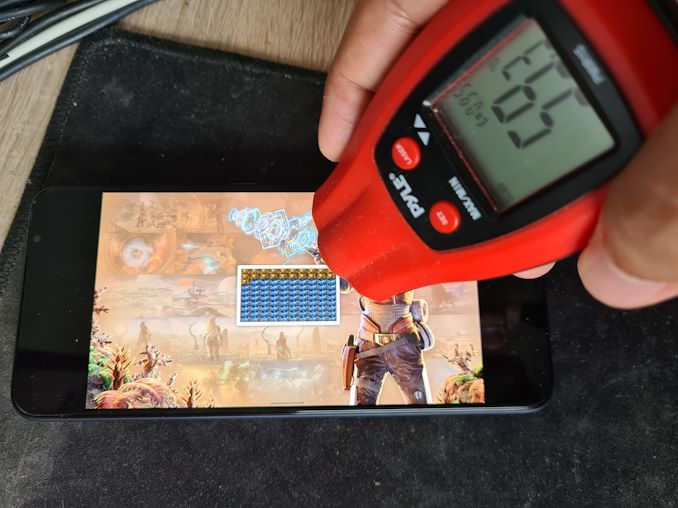
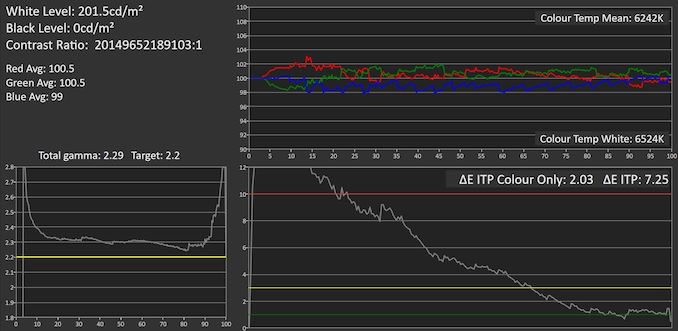

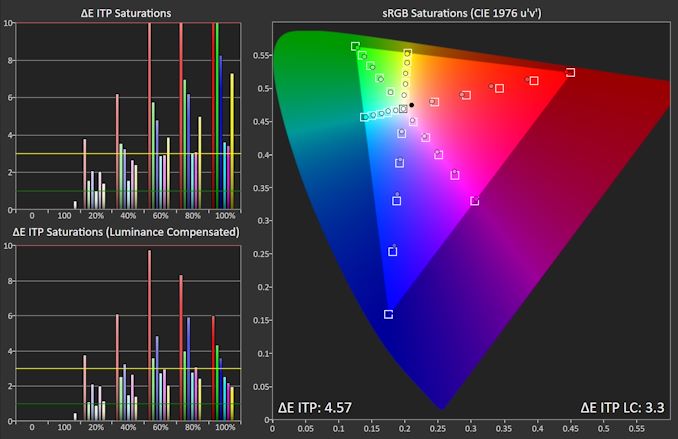
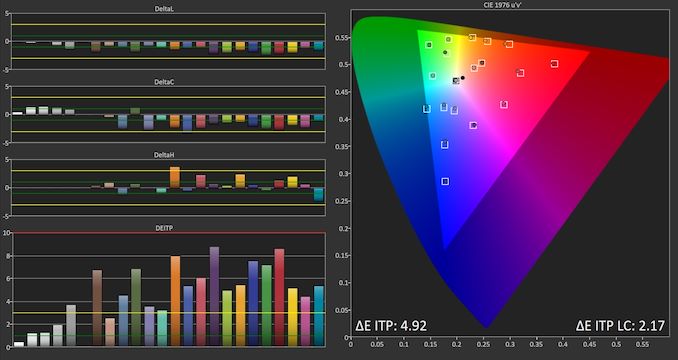


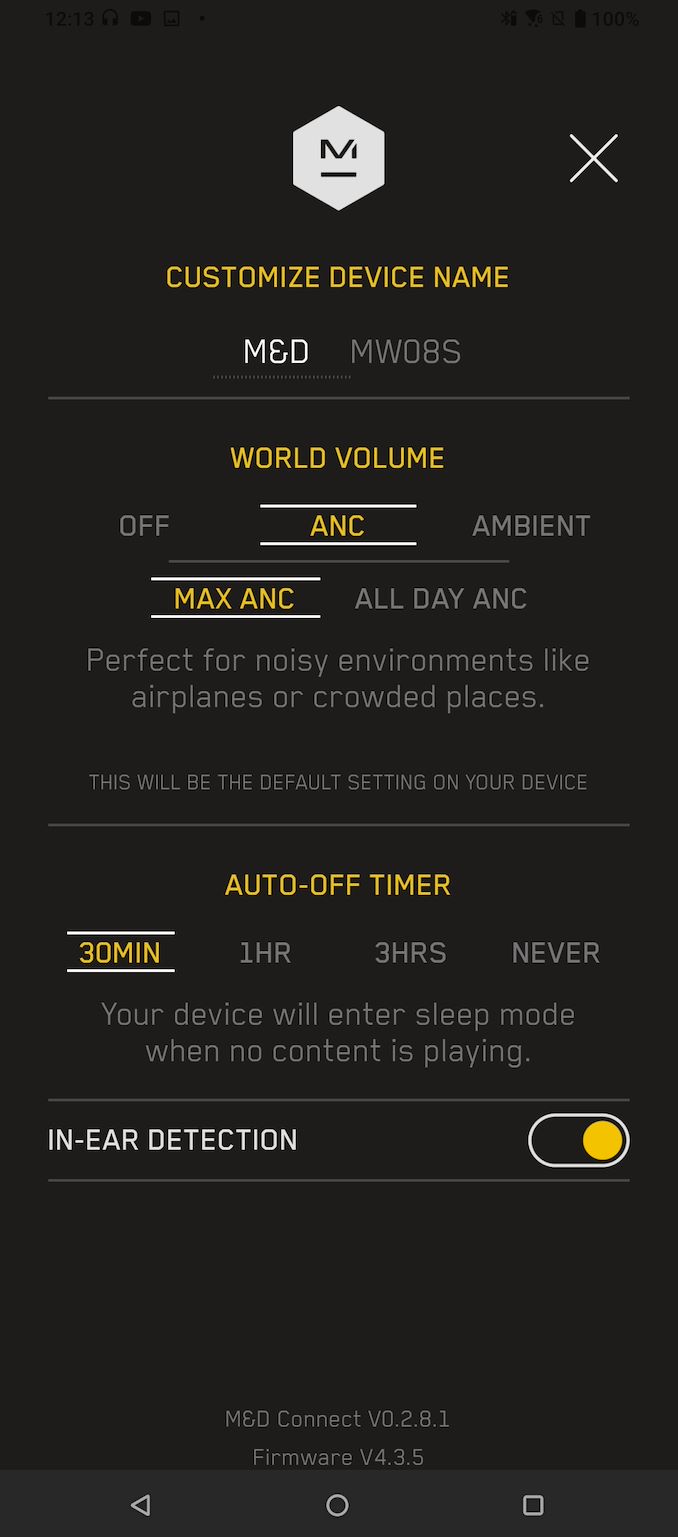
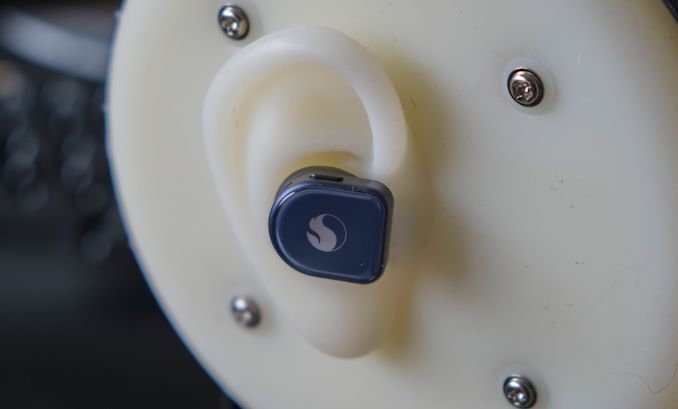
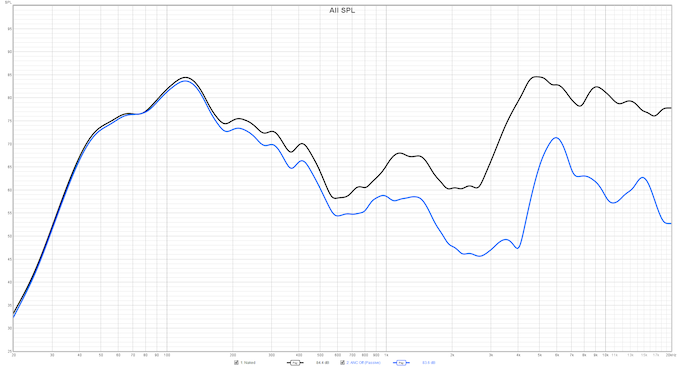
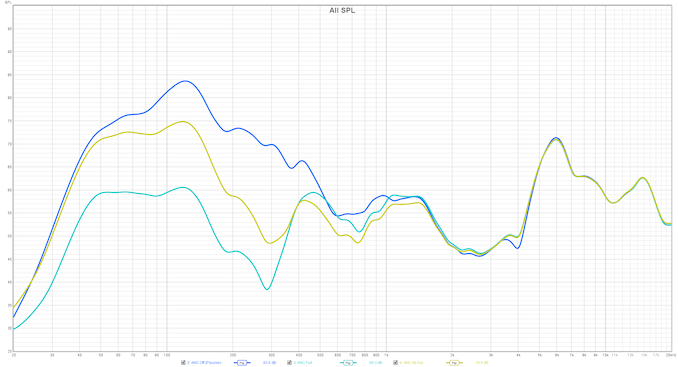
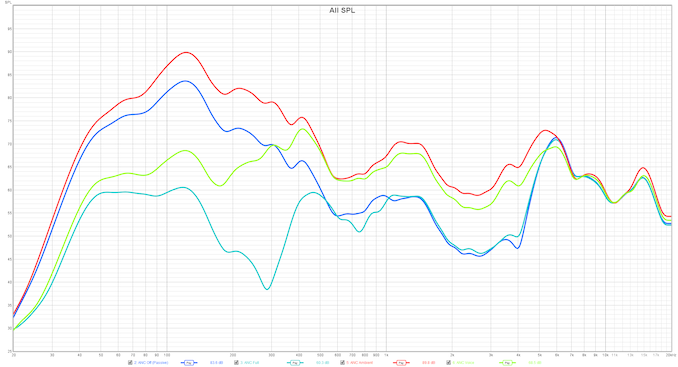
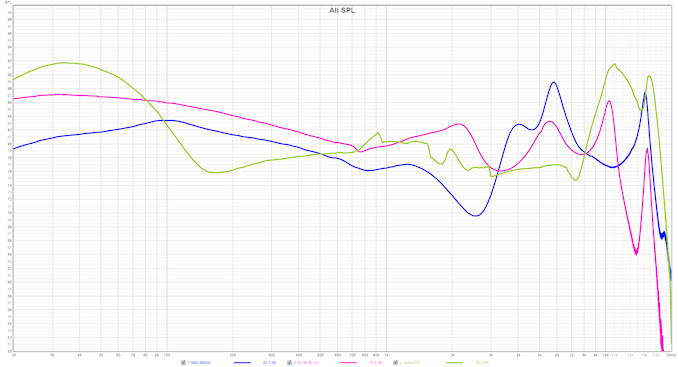
















0 Response to "The "Smartphone for Snapdragon Insiders" vs ROG5 Preview: Branded vs Original - AnandTech"
Post a Comment